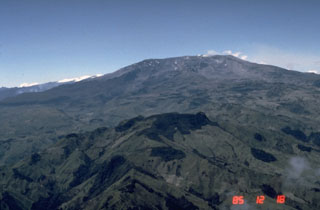Report on Nevado del Ruiz (Colombia) — 28 March-3 April 2012
Smithsonian Institution / US Geological Survey
Weekly Volcanic Activity Report, 28 March-3 April 2012
Managing Editor: Sally Sennert.
Please cite this report as:
Global Volcanism Program, 2012. Report on Nevado del Ruiz (Colombia) (Sennert, S, ed.). Weekly Volcanic Activity Report, 28 March-3 April 2012. Smithsonian Institution and US Geological Survey.
Nevado del Ruiz
Colombia
4.892°N, 75.324°W; summit elev. 5279 m
All times are local (unless otherwise noted)
According to INGEOMINAS, the Observatorio Vulcanológico and Sismológico de Manizales reported that during 24-31 March seismicity at Nevado del Ruiz increased significantly. Earthquakes indicating rock fracturing occurred W of Arenas crater, exhibiting a pattern observed prior to the eruptions in 1985 and 1989, although less energetic. Starting at 1054 on 29 March, and lasting for about 25 minutes, more than 135 earthquakes were detected S of Arenas crater at a depth of 4 km. At 0400 on 31 March earthquake signals indicating rock fracturing and fluid movement markedly increased. The Alert Level was raised to II (Orange; "eruption likely within days or weeks"). Seismicity remained elevated during 1-3 April; earthquakes were located below Arenas crater at depths between 0.5 and 3 km.
Geological Summary. Nevado del Ruiz is a broad, glacier-covered volcano in central Colombia that covers more than 200 km2. Three major edifices, composed of andesitic and dacitic lavas and andesitic pyroclastics, have been constructed since the beginning of the Pleistocene. The modern cone consists of a broad cluster of lava domes built within the caldera of an older edifice. The 1-km-wide, 240-m-deep Arenas crater occupies the summit. The prominent La Olleta pyroclastic cone located on the SW flank may also have been active in historical time. Steep headwalls of massive landslides cut the flanks. Melting of its summit icecap during historical eruptions, which date back to the 16th century, has resulted in devastating lahars, including one in 1985 that was South America's deadliest eruption.

